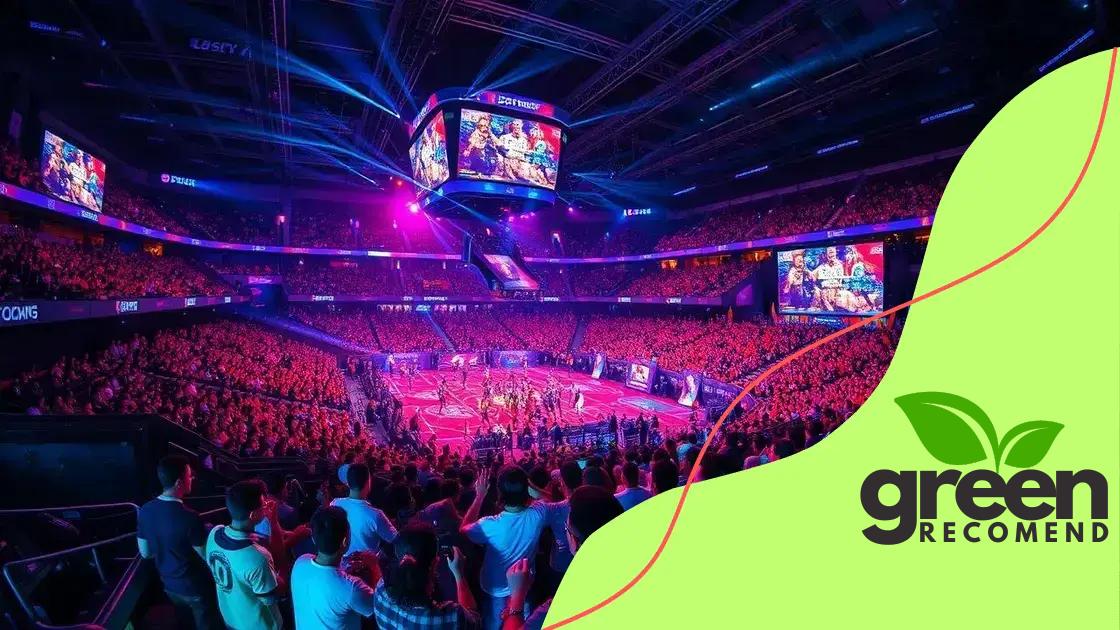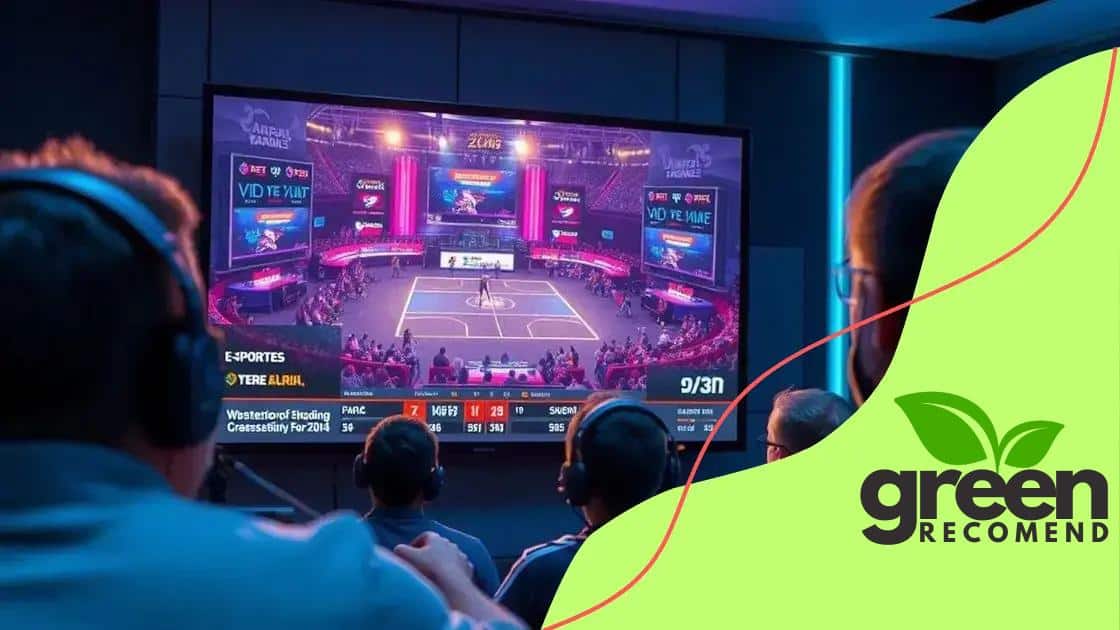How e-sports are influencing mainstream media content

How e-sports are influencing mainstream media content involves integrating gaming with traditional media, enhancing viewer engagement through interactivity, immersive experiences, and innovative advertising strategies that effectively reach diverse audiences.
How e-sports are influencing mainstream media content is a fascinating topic that reveals a blend of gaming with traditional formats. Have you ever wondered how these digital competitions captivate millions and reshape storytelling? Let’s dive into this dynamic intersection!
The rise of e-sports in popular culture
The rise of e-sports in popular culture has transformed the entertainment landscape in recent years. No longer just a niche market, e-sports has grown into a mainstream phenomenon, attracting millions of fans globally. This shift highlights how digital competitions are now dominating traditional media.
The Popularity Explosion
One reason for this surge is the accessibility of gaming and streaming platforms. Today, anyone with an internet connection can watch their favorite players compete. This inclusivity has broadened the audience significantly, pulling in viewers from various backgrounds and age groups.
Key Factors Contributing to Growth
- Advanced streaming technology and platforms, like Twitch and YouTube Gaming, allow real-time interaction.
- Major events, such as the League of Legends World Championship, draw large crowds, both in-person and online.
- Collaborations between gaming companies and traditional media enhance visibility.
The integration of e-sports into popular media is vivid. Traditional sports figures are entering the gaming space, reflecting a blend of interests among diverse demographics. Games are even being included in social gatherings and cultural events, enjoying broad recognition and appeal.
Moreover, brands are starting to take notice. Advertisers recognize the e-sports audience as valuable, leading to sponsorship deals and product placements during high-stakes tournaments. This benefit elevates the industry’s status, merging the world of gaming with mainstream marketing.
Community and Cultural Impact
E-sports has also fostered a community among fans, creating a culture rich in shared experiences. Fans gather to celebrate their favorite teams and players, fostering a sense of belonging. This new culture encourages participation, whether through playing games, watching streams, or attending live events.
Such dynamics show that the rise of e-sports is reshaping not just how we consume entertainment, but also how we connect with one another through shared passions and interests.
How e-sports are changing content consumption
How e-sports are changing content consumption is a fascinating development in the digital age. The way people engage with media has evolved dramatically, thanks in large part to the popularity of live gaming events.
The Shift to Interactive Experiences
Viewers are no longer passive consumers of content. Thanks to platforms like Twitch and YouTube, audiences can watch live streams and participate in real time. This shift has created an interactive environment where fans can influence the experience.
Key Changes in Viewing Habits
- Viewers engage with chat features, making commentary on plays and strategies.
- Fan voting and polls influence in-game decisions during streams.
- Social media enhances community interaction around events.
This interaction extends beyond gaming. Traditional television is integrating e-sports elements, such as live discussions and real-time stats, to keep audiences engaged. Viewers find themselves emotionally invested, cheering for their favorite players and teams as if they were at a live sports event.
Moreover, as e-sports gains mainstream acceptance, brands are seizing the opportunity to connect with younger demographics. Advertisers create tailored content that resonates with gaming culture, reflecting the interests and values of the audience. As a result, sponsorship deals have become prevalent, aligning brands with popular gaming events.
Future of Content with e-sports Influence
Looking ahead, the fusion of e-sports with other content forms seems promising. We might see more hybrid events that combine gaming with traditional sports or entertainment. This convergence can deepen audience engagement and provide new ways to consume content.
The evolving landscape of content consumption showcases the dynamic nature of both e-sports and media consumption. Gamers and traditional viewers alike are responding to these changes, reinforcing the idea that interactivity and community are at the forefront of modern entertainment.
The relationship between e-sports and traditional media

The relationship between e-sports and traditional media is increasingly intertwining, showcasing how digital gaming is reshaping entertainment. Over recent years, traditional broadcasting networks have recognized the massive potential of e-sports and are adapting accordingly.
Synergy Between Two Worlds
Television networks are now broadcasting major e-sports events, embracing this new trend. For example, tournaments for games like League of Legends and Dota 2 have taken center stage on channels that once focused solely on sports. This change reflects the recognition of e-sports as a legitimate form of competition.
Impact on Viewer Engagement
- Viewers can now watch e-sports live on television, expanding accessibility.
- Collaborations between game publishers and media outlets create unique content.
- Traditional sports stars are entering the e-sports arena, increasing mainstream appeal.
This crossover enhances audience engagement. Fans are not just watching; they are interacting through social media, supporting their favorite teams, and participating in conversations around the events. The integration of e-sports into mainstream media also appeals to younger viewers who crave fresh, interactive content.
Moreover, advertisers see value in targeting this demographic and are quickly adapting their strategies. Brands are crafting promotional content that resonates with both gaming enthusiasts and general sports fans, blending traditional advertising with modern content approaches. The impact is significant as more brands sponsor e-sports events, acknowledging the audience’s potential.
Future Prospects for E-sports and Traditional Media
The future will likely see even more synergistic opportunities. As technology evolves, we may witness more immersive viewing experiences, combining augmented reality with live e-sports events. This could redefine how fans interact with both gaming and traditional media.
Ultimately, the relationship between e-sports and traditional media promises to grow stronger, creating exciting new pathways for content consumption and audience engagement.
Impact of e-sports on advertising strategies
The impact of e-sports on advertising strategies is profound, as brands are beginning to recognize the unique value of reaching the gaming audience. Unlike traditional advertising methods, which often find it hard to engage younger viewers, e-sports offers a direct line to a dedicated fanbase that is passionate and engaged.
Shift in Advertising Focus
Companies are shifting their focus from conventional media to platforms where gamers gather. Ads are becoming more integrated into the gaming experience, making them more relevant and less intrusive. This change means that brands must think creatively about how to connect with their audience.
Strategies to Connect with Gamers
- Utilizing in-game advertising to place products directly within games.
- Partnering with popular streamers to reach their followers effectively.
- Creating immersive content that resonates with the gaming community.
Additionally, e-sports provides measurable data that enables brands to assess their campaigns’ effectiveness. Through analytics, companies can understand viewer preferences and adjust their strategies accordingly. This adaptability helps brands remain relevant in a fast-paced environment.
The rise of social media platforms has enhanced the effectiveness of e-sports advertising. Brands can engage with fans in real-time, responding to their feedback, and creating a two-way conversation. This approach fosters loyalty, as fans feel more connected to the brands they support.
Brand Sponsorships and Collaborations
Sponsorships in e-sports are also transforming how brands interact with consumers. Major companies sponsor tournaments, which not only increases visibility but also aligns their brand with the excitement of competition. This strategy elevates brand perception and connects them to a passionate audience.
Moving forward, the relationship between e-sports and advertising will likely continue to evolve. With the growth of virtual and augmented reality, we may see more innovative advertising techniques emerge that blend entertainment with marketing seamlessly. The focus will remain on creating engaging, authentic experiences that cater to the interests of the gaming community.
Future trends in e-sports and media integration
The future trends in e-sports and media integration hold exciting possibilities for both gaming and entertainment. As technology rapidly evolves, the way we engage with e-sports content is expected to transform significantly.
Enhanced Viewer Experience
One key trend is the development of immersive viewing experiences. Virtual and augmented reality (VR and AR) technologies are paving the way for fans to feel like they are part of the action. This immersive experience could allow viewers to select their perspective during live events, bringing a new level of excitement.
Innovative Content Formats
- Short-form content focusing on highlights and key moments for easy sharing.
- Interactive live streams where viewers can influence game outcomes through voting.
- Documentaries and behind-the-scenes features showcasing player lives and strategies.
Additionally, platforms may begin to offer personalized content recommendations based on viewer preferences. By using data analytics, media companies can tailor experiences to fit the interests of individual fans, maximizing engagement.
The convergence of e-sports with mainstream media is also expected to deepen. Traditional sports networks will likely continue to blend e-sports into their programming, hosting special events and integrating gaming content into broadcasts. This merger can attract a broader audience, merging the worlds of traditional sports and gaming.
Impact of 5G Technology
The rollout of 5G technology will play a crucial role in shaping the future of e-sports and media integration. With faster and more reliable internet connections, game streaming will become smoother and more accessible. This improvement opens the door for more players to participate and for viewers to enjoy an enhanced, high-quality viewing experience.
As e-sports continues to grow, new business models will likely emerge, further bridging the gap between the gaming industry and traditional media. The future promises a landscape where e-sports will not just coexist with other forms of entertainment but thrive alongside them, creating engaging experiences that resonate with a diverse audience.
Conclusion:
The world of e-sports is evolving rapidly, shaping the future of entertainment and media. As gaming continues to grow, its influence on mainstream culture becomes increasingly evident. New technologies like VR and AR will enhance viewer experiences, making participation more thrilling. Integrating e-sports with traditional media is creating more opportunities for fans and brands alike. As we move forward, we can expect even more creative advertising strategies and innovative content formats that cater to diverse audiences. The future of e-sports is bright, promising exciting developments ahead for both gamers and fans.
FAQ – Frequently Asked Questions about E-sports and Media Integration
How are e-sports changing the way we consume media?
E-sports are creating interactive viewing experiences where fans can participate in real-time, making content consumption more engaging and dynamic.
What impact does VR and AR have on e-sports?
VR and AR technologies enhance the viewer experience by allowing fans to feel immersed in the game, providing a richer connection to the action.
How are advertisers adapting to the rise of e-sports?
Advertisers are creating integrated campaigns that resonate with gamers, using platforms popular among e-sports fans to reach a dedicated audience effectively.
What future trends can we expect in e-sports?
Expect more innovative content formats, enhanced viewer experiences through technology, and continued integration with traditional media as e-sports evolves.





